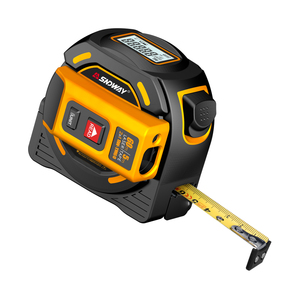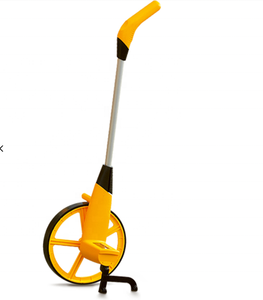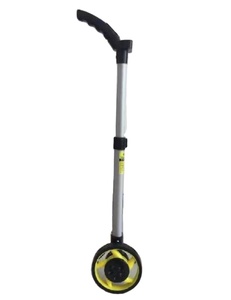
All categories
Featured selections
Trade Assurance
Buyer Central
Help Center
Get the app
Become a supplier

(1881 products available)













































digital measuring wheel are essential tools in various industries for precise measurement and gauging tasks. These tools encompass a wide range of devices designed to measure physical quantities such as length, weight, temperature, pressure, and more. The accuracy and reliability of digital measuring wheel make them indispensable in fields like engineering, manufacturing, construction, and scientific research. They ensure that measurements are consistent, enabling professionals to maintain quality control and adhere to strict standards. As technology advances, digital measuring wheel continue to evolve, offering enhanced features and capabilities to meet the ever-growing demands of modern industries.
The diversity of digital measuring wheel is vast, with each type tailored to specific measurement tasks. Common types include calipers, micrometers, dial indicators, and pressure gauges. Calipers are versatile tools used for measuring the distance between two opposite sides of an object, while micrometers offer a higher degree of precision for smaller dimensions. Dial indicators are essential for measuring small linear distances and ensuring alignment in mechanical systems. Pressure gauges, on the other hand, are crucial for monitoring and maintaining the correct pressure within systems. Each digital measuring wheel is designed with unique specifications to accommodate different measurement requirements, ensuring accuracy and efficiency in their respective applications.
The primary function of digital measuring wheel is to provide accurate measurements, which are vital for quality control and compliance with industry standards. These tools come equipped with various features to enhance their usability and precision. Digital displays, for example, offer clear and easy-to-read measurements, reducing the chances of human error. Some digital measuring wheel also include data logging capabilities, allowing users to record and analyze measurements over time. Additional features such as adjustable calibration, zero-setting functions, and shock-resistant designs further ensure the reliability and durability of these tools. By incorporating these advanced features, digital measuring wheel facilitate efficient and precise measurement processes across different industries.
The construction of digital measuring wheel involves the use of high-quality materials to ensure durability and accuracy. Stainless steel is a common material used for its strength and resistance to corrosion, making it ideal for tools exposed to harsh environments. Some digital measuring wheel also incorporate hardened alloys to withstand wear and tear during repetitive use. The precision of these tools is often achieved through meticulous manufacturing processes, such as CNC machining and laser calibration, which ensure tight tolerances and consistent performance. The choice of materials and construction techniques directly impacts the lifespan and reliability of digital measuring wheel, making them suitable for demanding measurement applications.
To maximize the effectiveness of digital measuring wheel, it is crucial to understand their proper usage and limitations. Begin by selecting the appropriate tool for the measurement task, ensuring that it is calibrated and in good working condition. When using digital measuring wheel, apply consistent pressure and maintain a steady hand to achieve accurate readings. Regular maintenance, such as cleaning and calibration checks, is essential to preserve the tool's precision over time. Additionally, users should be familiar with the specific features and functions of each digital measuring wheel, such as zero-setting and data logging, to fully leverage their capabilities. By following these guidelines, professionals can ensure reliable and precise measurements in their operations.
Selecting the appropriate digital measuring wheel requires careful consideration of several factors to ensure optimal performance in specific applications. Firstly, understanding the measurement range and precision requirements is crucial. Tools such as micrometers and calipers are designed for different levels of accuracy, so it's essential to match the tool's capabilities with the task at hand. Additionally, the environment in which the digital measuring wheel will be used plays a significant role. Factors like temperature variations, exposure to moisture, and potential contamination can impact the tool's effectiveness. Choosing materials that can withstand these conditions, such as stainless steel or hardened alloys, can enhance durability and reliability.
Another key aspect is the ease of use and ergonomics of the digital measuring wheel. Tools with digital displays and intuitive interfaces can greatly simplify the measurement process, reducing the likelihood of errors. Ergonomic designs that fit comfortably in the hand can improve user experience and efficiency, especially during prolonged use. It's also important to consider additional features such as data logging and connectivity options, which can facilitate better analysis and integration with other systems. By focusing on these criteria, professionals can select digital measuring wheel that not only meet their measurement needs but also enhance overall productivity.
One common challenge with digital measuring wheel is ensuring accuracy in varying environmental conditions. Temperature fluctuations and humidity can affect measurements, requiring regular calibration to maintain precision. Another challenge is the potential for human error during the measurement process, which can be mitigated by using tools with digital displays and user-friendly interfaces. Additionally, wear and tear from frequent use can impact the tool's performance, necessitating proper maintenance and timely replacement of worn components.
Advancements in technology have significantly enhanced the functionality of digital measuring wheel. Digital tools offer features like automatic data logging and wireless connectivity, allowing users to easily record and analyze measurements. Integration with software systems can facilitate real-time monitoring and reporting, improving decision-making processes. Furthermore, the use of advanced materials and manufacturing techniques, such as CNC machining and laser calibration, ensures higher accuracy and durability.
Calibration of digital measuring wheel is vital for maintaining accuracy and reliability. It's important to follow the manufacturer's guidelines and use certified calibration standards to ensure consistency. Regular calibration checks should be scheduled based on the tool's usage frequency and the precision required for specific applications. Environmental factors such as temperature and humidity should also be considered, as they can affect calibration results. Proper handling and storage of calibration equipment are essential to prevent damage and ensure accurate calibration.
Yes, digital measuring wheel can often be customized to suit specific applications. Manufacturers may offer tools with unique specifications, such as extended measurement ranges or specialized materials, to meet particular industry requirements. Custom features like data connectivity options, enhanced durability, or ergonomic designs can also be tailored to improve functionality and user experience. Consulting with manufacturers or suppliers can provide insights into available customization options.
To ensure the longevity and accuracy of digital measuring wheel, regular maintenance is essential. Cleaning the tools after each use can prevent dirt and debris buildup, which may affect performance. Calibration checks should be conducted periodically to verify accuracy, and any worn or damaged components should be replaced promptly. Storing tools in a controlled environment, away from extreme temperatures and humidity, can also protect them from potential damage. Following these maintenance practices can help sustain the tool's precision and extend its lifespan.